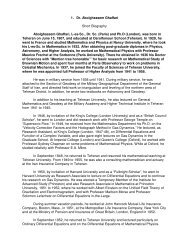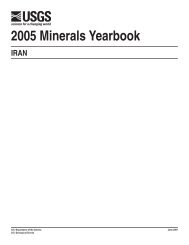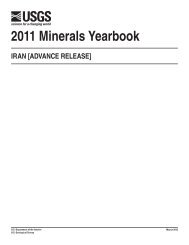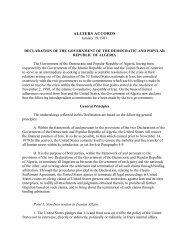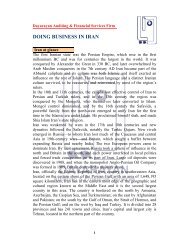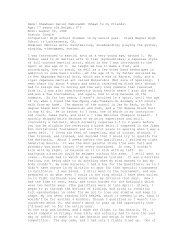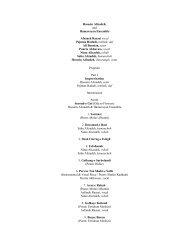Create successful ePaper yourself
Turn your PDF publications into a flip-book with our unique Google optimized e-Paper software.
<strong>Iran</strong> <strong>Country</strong> <strong>Analysis</strong> <strong>Brief</strong><br />
about 35,000 bbl/d of Turkmen and Kazakh oil were being shipped to Neka,<br />
down 75 percent compared to levels during the summer of 2004 as price<br />
differentials between sweet and sour crude rendered the swaps less<br />
competitive with Meditteranean routes. From Neka, oil is then sent to Tehran<br />
by the existing 170,000-bbl/d capacity Neka-Tehran pipeline. Eventually, <strong>Iran</strong><br />
hopes to upgrade its facilities in order to greatly expand oil swaps, partly in<br />
order to compete with the 1-million-bbl/d Baku-Tbilisi-Ceyhan (BTC)<br />
pipeline, scheduled to open in late 2005.<br />
<strong>Iran</strong> plans to boost capacity at its northern refineries at Arak, Tabriz, and<br />
Tehran in order to process additional Caspian oil, to boost Neka-Tehran<br />
pipeline capacity to 500,000 bbl/d, and also to increase port capacity at Neka<br />
to 500,000 bbl/d. In August 2003, a $500 million tender was issued to<br />
upgrade the Tehran and Tabriz refineries in order to handle 370,000 bbl/d of<br />
high sulfur Caspian crude. This follows a $330 million project, completed by<br />
a Sinopec-led consortium in late 2003, to expand storage at Neka and to<br />
upgrade the Tehran and Tabriz refineries.<br />
Aside from Caspian "swaps," there were reports in February 2005 that <strong>Iran</strong><br />
and Iraq were discussing a framework swap agreement involving possible<br />
construction of a 24-mile, 350,000-bbl/d oil pipeline from Basra to the<br />
Abadan refinery in southwestern <strong>Iran</strong>. In exchange, <strong>Iran</strong> would export a<br />
similar volume of oil from Kharg Island, crediting Iraq minus a swap fee.<br />
Refining and Transportation<br />
As of January 2005, <strong>Iran</strong> had nine aging (most built before the 1979 <strong>Iran</strong>ian<br />
revolution) but operational refineries with a combined capacity of 1.47<br />
million bbl/d. Major refineries include: Abadan (400,000-bbl/d capacity);<br />
Isfahan (265,000 bbl/d); Bandar Abbas (232,000 bbl/d); Tehran (225,000<br />
bbl/d); Arak (150,000 bbl/d); and Tabriz (112,000 bbl/d). In order to meet<br />
burgeoning domestic demand for middle and light distillates (gasoline<br />
demand is growing at around 9 percent per year), <strong>Iran</strong> plans to increase its<br />
refining capacity, possibly to 2.2 million bbl/d by 2008. One goal of this<br />
expansion is to allow <strong>Iran</strong>'s refineries to process a heavier crude slate while<br />
http://www.eia.doe.gov/cabs/iran.html (11 of 32) [3/30/2005 8:12:05 AM]



